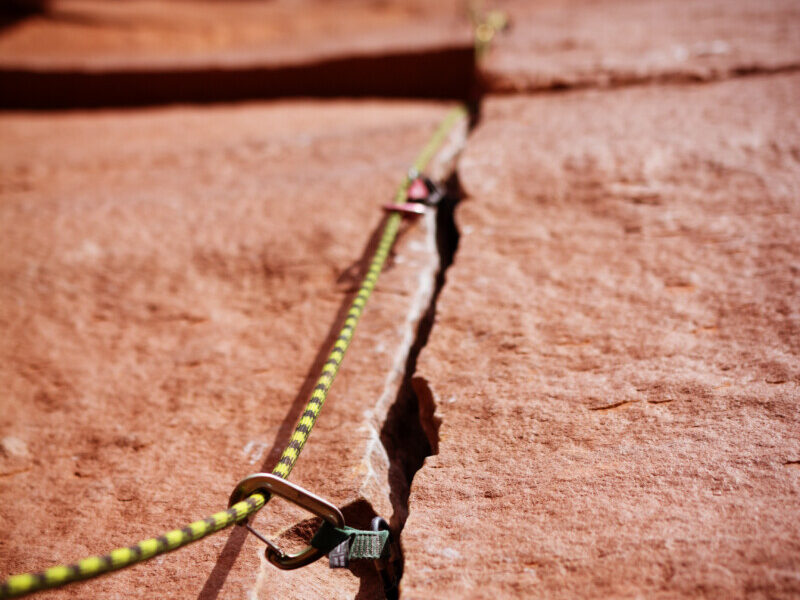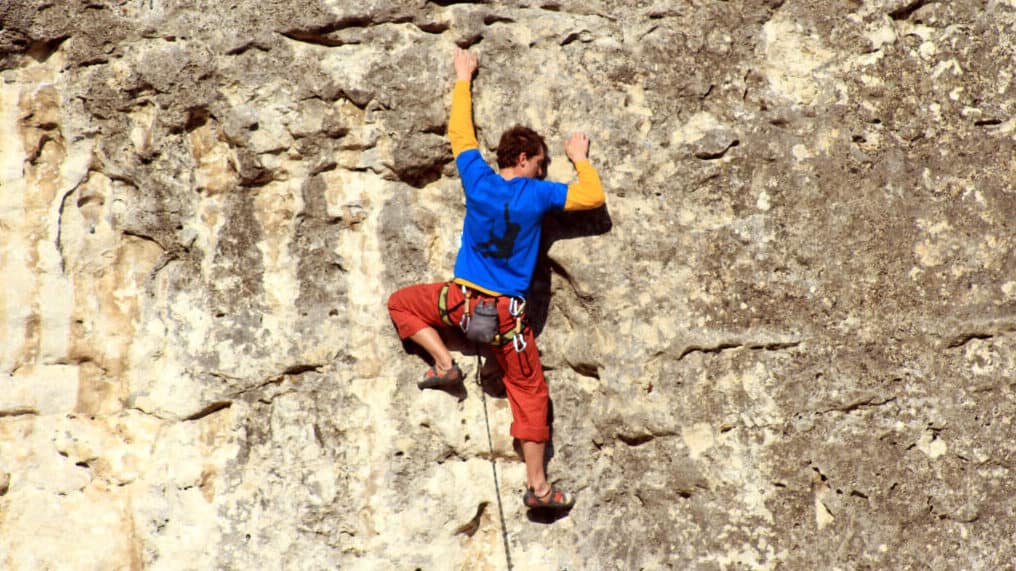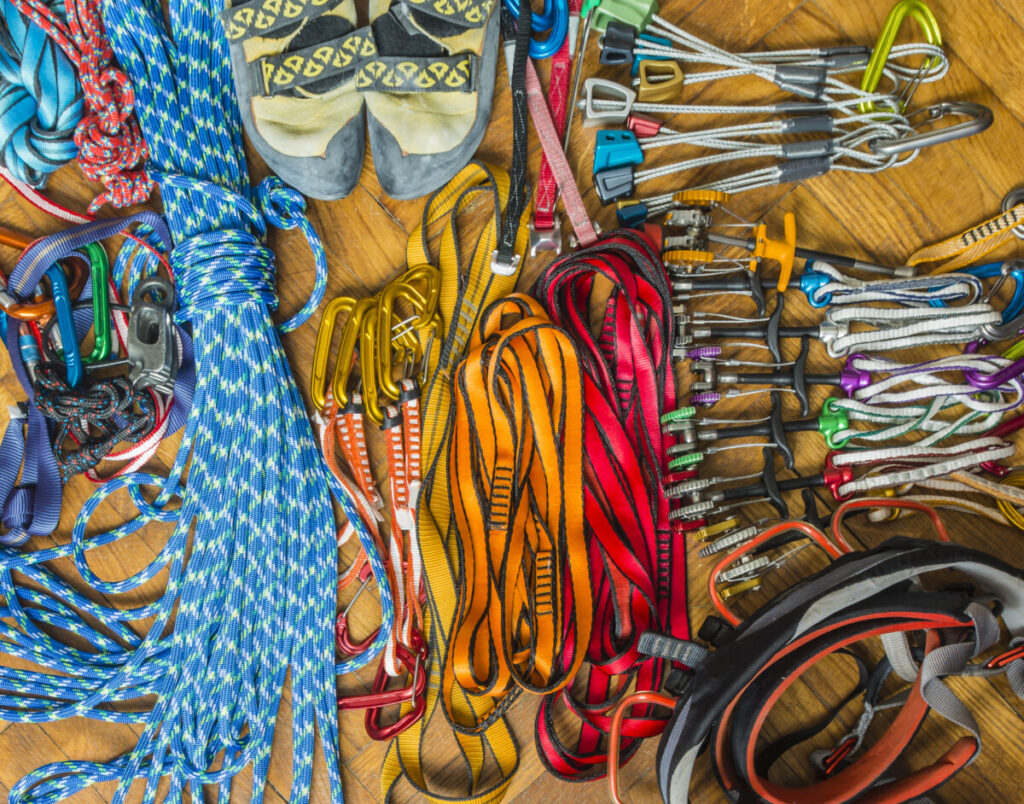
As a climber advances up the route of the rock face, they add and clip into protection along the way. Protection should be as secure as possible. A bolt securely fastened to the wall or a nut or a cam wedged tightly in a crack offer the climber enough protection to withstand the impact force of an inadvertent fall. The distance between placements of good protection depends on the comfort level of the climber, potential fall risks and the available features of the rock face.
Aid climbing incorporates the use of fixed or temporary protection as an aid to take the weight of the climber and to be leveraged in making progress along sections of a climbing route that may be impossible to free climb or exceed the climber’s skill level. Aid climbing is most often used on big-wall routes that usually take climbers more than one day to complete.
What is Considered an Aid in Rock Climbing?
Technically, anytime a climber shifts their weight from the rock face to the rope to help advance, take a break, or to receive protection during a fall, is considered to have used an “aid” on the climb. In aid climbing, the climber intentionally uses their aid in order to facilitate forward progress. Additionally, they may use climbing ladders and etriers, called aiders, to help with ascension.
At the crag, a climber may have various route options to climb. Learning a route often involves relying on aid (or protection and the rope) to take the weight of the climber in order to rest, assess the route, take a fall, or to ascend the rope back to a section of the climb that the climber is working on. The ultimate objective of the climber, however, is to be able to maximize their climbing capabilities and “send” a particular route without relying on any climbing aid. An official “send” is one where the climber meets the climbing objective by free climbing without relying on any of their climbing gear to take their weight or provide an aid during the climb.
Sending a route does not mean that the climber ascends without the use of protection. Protection should always be readily available. Toprope, sport, and traditional climbing are all techniques where protection and safety measures are made available to prevent death or injury from a fall or to simply allow the climber resting opportunities along the route. However, regardless of the climbing, belaying, or safety methods used, when a climber “sends” a route, they simultaneously free climb without the need for their climbing system to take their weight and they demonstrate their climbing proficiency for that route and its free climbing difficulty rating.
The end goal at the crag is to send. The myriad of climbing routes and bouldering problems offers everyone from novice climbers to experienced professionals the opportunity to push limits and perfect technique. It can take weeks or even months to build the strength and perfect technique necessary to send a difficult route—and the sense of accomplishment is second to none.
Aid Climbing is Different than Top-Rope, Sport, and Traditional Climbing

Big wall climbing routes are big and technical. Many big wall routes have a vertical gain of more than 1,000 feet or 300 meters and some gain more than 3,000 feet or 900 meters. Big wall routes are broken down into multiple pitches that typically range from 100 to 200 feet (30 to 60 meters). A single pitch can be extremely technical and may take hours for the climber to complete. Additionally, big wall climbing is gear heavy and climbers will likely spend more than one day on the rock face (sometimes weeks) to complete a route.
Highly experienced climbers may have difficulty climbing 5.10 to 5.12 routes when their legs, hands and fingers are extremely pumped and tired from hours and hours of climbing. Even amongst professionals there are only a select few that can send difficult big wall routes without aid.
Given its technical nature, remote location, length of time required, and the vast number of pitches on a single big wall route, it is extremely difficult for climbers to have the opportunity to put in the reps and training needed to be able to, in the end, send the entire route. It is a given that most climbers will need to rely on their climbing gear as an aid in order to take a break, reposition, or to make forward progress. Aid climbing makes the big wall rock face more accessible to climbers.
Aid Climbing Rating System: Defines Aid Quality and Fall Risk
Big wall routes are given a rating with three identifiers: class, aid rating, and grade that indicate the maximum free climb difficulty that can be identified on the route, the most difficult available aid that exists on the route, and the amount of time likely required in order to complete the route. The ratings give a snapshot of skill set, maximum risk and time investment.
For example, The Nose—a big wall classic on El Capitan in Yosemite National Park, has a free climbing rating of 5.13+ and an aid climbing rating of: 5.9, C2, VI.
If someone were to free climb, they would encounter section(s) of the climb with a maximum difficulty rating of 5.13+, which lends itself to very highly experienced climbers.
However, as mentioned above, aid climbing makes the wall more accessible. In the case of The Nose on El Cap, with an aid climbing rating of 5.9, C2, VI, the most difficult section of pitch that must be free climbed has a difficulty rating class of 5.9. The pitch with the most difficult available clean aid is rated C2—good aid but challenging to find or place, and the amount of time that it can take is VI—two or more days.
It is important to mention that a big wall’s overall rating just gives a snapshot of the wall’s maximum difficulty and how long it may take to climb. The overall rating does not tell the whole story. Anyone seriously considering a big wall climb will want to know the specific ratings of each individual pitch to get a much better idea of how much a specific class, rating, or fall risk is sustained during the overall climb.
Breaking down The Nose, one finds that the 3,400 ft vertical climb (1036 meters) has 31 pitches. Of the 31 pitches, only 1 has an aid rating of C2 where protection is good but challenging to place or difficult to find. The vast majority of pitches are rated C1 or easy aid.
An identically rated big wall climb may have fewer pitches or more pitches that sustain the maximum rating.
Defining the Aid Climbing Ratings:
The United States and Europe have a similar aid rating system. The rating system for aid climbing is divided into two categories. Aid climbing routes are given an “A” rating or a “C” rating, or both.
“A” ratings refer to the application of fixed aid via bolting or the hammering of pins or pitons into the rock. “C” ratings refer to clean aid—or aid that can be removed or “cleaned” from the route such as hooks, nuts, and cams—or aid that does require the use of a hammer. In the U.S. the aid ratings range from A0 to A6 or C0 to C6.
With that in mind, consider the definition of “A” ratings from A0 to A6—with “A” routes likely requiring the implementation of fixed aid with a hammer and “C” routes requiring clean aid only.
| A0 or C0 | Also called “Free French”. All aid for climbing progress is solid—”good protection (or pro)” that will take a climber’s fall. Also progress can be made without the use of climbing aiders such as ladders and etriers. |
| A1 or C1 | Easy Aid. Climbing placements and aid is solid—all of them could hold a fall. The use of climbing aiders such as: ladders and etriers will likely be needed. |
| A2 or C2 | Moderate Aid. Most aid placements are solid but may be difficult, awkward or challenging to find or place. There may be a couple of tenuous or sketchy placements above good protection. |
| A2+ or C2+ | Same as A2 or C2, however the tenuous placements could subject the climber to the risk of falls 20 to 30 feet (or up to 10 meters). |
| A3 or C3 | Hard Aid. Solid protection found within the pitch, however, may require several tenuous back to back placements—subjecting the climber to fall risk of 60 to 80 feet (18-24 meters). No risk of decking out or grounding (falling and hitting the ground or base of the climb. Leading the pitch can take several hours. |
| A3+ or C3+ | Same as A3 or C3, however, falls subject the climber to serious impact risk from whipping or decking out. |
| A4 or C4 | Serious Aid. Multiple tenuous or sketchy aid placements with many of them holding body weight only. Fall potential risk is 80 to 100 feet (24 to 30 meters) with potential dangerous landings. Several hours leading the pitch. |
| A4+ or C4+ | Same as A4 or C4 with much more time on the pitch. Movement is slow, articulate, and steady. |
| A5 or C5 | Extreme Aid. All aid placements are tenuous or sketchy. Most aid may hold body weight only. Potential fall potential of from 150 feet or 45 meters could mean the total fall distance could be 300 feet or 80 meters with significant risk of impact with rock features or the ground. |
| A6 or C6 | A5 or C5 climbing with tenuous or sketchy belay anchors. Because the blay anchors are unreliable, both the climber and belayer are subjected to the significant risk of a fall leading to grounding, decking, or collision with other rock features. |
Please note, in the climbing community, it is generally accepted that ratings can be subjective. There are many attributes of a climber that vary widely, such as: the ability to manage stress, fear and risk, the efficacy of route finding, the efficiency equipment usage, and of course the variance in body composition—such as height, arm and leg span, center of gravity, muscle mass, finger dexterity and endurance. All of these attributes and more can cause a varying degree of difficulty for a climber to find and add protection along a specific route or pitch.
Therefore a specific rating that identifies a pitch may be subjectively evaluated differently from one climber to another.
Defining the Free Climbing Class Ratings:
5.6 to 5.8 is considered novice level free climbing filled with big jugs, deep crimps and easy foot placement.
5.9 to 5.10 can also be climbed by novice climbers, however, climbing is more strenuous. Holds may require more athleticism. Routes may have fewer jugs with narrower crimps and foot placement.
5.11 considered an intermediate level of climbing that requires improved footwork and hand strength stamina. Routes begin to incorporate more technical hand/finger placement and will require more stamina for slopers. Climbing technique begins to play a moderate factor.
5.12 climbing is generally considered a transition level between intermediate and experienced climbers and is where climbing technique and physical training begin to factor significantly in the climb.
5.13 routes require significant training, experience, and highly advanced technique.
5.14 and beyond require elite climbing technique and athleticism obtained by elite and/or professional climbers.
Grade: The National Climbing Classification System (NCCS) is commonly used to identify the amount of time or “commitment” for the average climber to complete the technical portion of a climbing route. It does not factor in the approach. The NCCS grades use a Roman numeral rating system from I to VII.
Grade I: Two or three hours.
Grade II: Half day or less.
Grade III: Most of one day.
Grade IV: Full day of climbing 5.7+.
Grade V: Likely to require an overnight on the technical portion of the climb.
Grade VI: two or more days of difficult climbing.
Grade VII: Several days or even weeks of technical climbing—expeditions located in highly remote areas with difficult free, aid, or alpine climbing.
The Aid Climbing Technique

Ideally, when faced with a difficult or nearly impossible section of wall to climb, a lead climber may find a need for a climbing aid to assist their climb.
Cams, nuts and hooks are the most commonly used aids when aid climbing.
First, the climber will have two daisy chains (or equivalent) girth hitched to their belay loop(s) on their harness. At the end of each daisy chain, the climber will clip on a ladder or etrier. These are clipped onto either side of the harness when not in use.
The climber will begin by attaching aid as high above them as possible. They will then extend one of their daisy chain/ladders and clip it onto the protection. They will bounce test their protection to determine whether it is suitable and will then ascend the ladder as far up as is possible.
Standing on the highest possible rung of their ladder, they will again reach up and add protection/aid above them. They will then clip the other daisy chain/ladder into the new protection and bounce test it to ensure it is secure. At this point, they will transfer their weight to the new system. Once the transfer is complete, they will simultaneously clip their belay rope into the protection below and remove the ladder. They will ensure their system is clean—belay rope is correctly clipped into the protection and that there are no tangles in their system.
The aid climbing process is then repeated.
Cam hooks are often used when the rock face does not offer protection for cam or nut placement. The hook is wedged into a crack or hooked on a crimp. The climber knows the protection is not good and will exercise extreme caution while proceeding with their ascension procedure. Cam hooks are also used as a third hand to allow the climber to attach better protection, or reposition themselves for better placement. Once protection is added or remanuvering is complete, the climber removes the hook and returns to the climb.
Pitons act as a fixed anchor when inserted int o the climbing wall. They are pounded into a crack in the rock face with a hammer and allow the climber to clip in and add protection along a route. Depending on the conditions, a piton may or may not be expected to protect the climber from a fall.
Ladders and etriers can be used to assist with forward progress where there is little or no availability for foot placement or when the climbing wall becomes inverted. They are either clipped on and ascend up the rope, or they are clipped into some sort of fixed or temporary placement.
The Free Climb and Aid Climbing Mix
Sometimes the belayer for a lead climber may not have the same level of experience or may be carrying excessive gear. They may be required to use climbing aids such as jumars and etriers that allow them to climb the rope past difficult sections of the climbing wall.
Jumars are an ascension device that give the climber a hand grip for pulling up the rope. Etriers provide a portable ladder system that allows the climber to use their feet to step up. Etriers are usually attached to the rope to aid with ascension. They can also be attached securely to a section of climb that may be inverted or lack foot holds.
Aid Climbing is Controversial
However, cam hooks can chip away or shear crimp holds causing degradation that could eventually cause standard holds to be unusable by free climbers. Also, pitons are extremely difficult to remove without damaging the rock face. The use of pitons was a primary method of adding protection in the early days of climbing. However, because the removal of pitons damages the rock face, and because other forms of removable protection are available, the use of pitons is generally discouraged.
Thus, aid climbing is considered by some to be a controversial climbing method where it is believed that climbers shouldn’t climb where they can’t free climb.
Aid Climbing is a High Risk Sport
Rock climbing is a high risk sport where mistakes and improper technique can lead to serious injury or death. It is critical for both the climber and belayer to mitigate risks by the incorporation of safety precautions and safety practices perfected through extensive guidance, professional training, and physical fitness. This article is intended to be informational only and is not a substitute for professional training and mentorship where climbing technique, risk awareness, and risk aversion practices can be properly evaluated, coached and perfected.
For more information on climbing ratings, visit the following websites: www.bigwalls.net/climb/Ratings.html
or www.cruxrange.com/blog/climbing-ratings-explained/
Also, the following book has a tremendous amount of information on climbing and mountaineering, including information on climbing ratings: Mountaineering, The Freedom of the Hills, The Mountaineers, 9th edition, 2017.